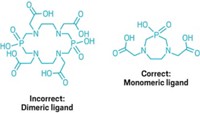Advertisement
Grab your lab coat. Let's get started
Welcome!
Welcome!
Create an account below to get 6 C&EN articles per month, receive newsletters and more - all free.
It seems this is your first time logging in online. Please enter the following information to continue.
As an ACS member you automatically get access to this site. All we need is few more details to create your reading experience.
Not you? Sign in with a different account.
Not you? Sign in with a different account.
ERROR 1
ERROR 1
ERROR 2
ERROR 2
ERROR 2
ERROR 2
ERROR 2
Password and Confirm password must match.
If you have an ACS member number, please enter it here so we can link this account to your membership. (optional)
ERROR 2
ACS values your privacy. By submitting your information, you are gaining access to C&EN and subscribing to our weekly newsletter. We use the information you provide to make your reading experience better, and we will never sell your data to third party members.
Physical Chemistry
Structure Quality
Crystal structures in 'hotter' journals tend to have more errors
by Stu Borman
August 20, 2007
| A version of this story appeared in
Volume 85, Issue 34

A COMPREHENSIVE STUDY of 14,518 crystal structures in the Protein Data Bank (PDB) reports what it calls "a striking result"—high-prestige journals tend to publish structures with more errors.
The study finds that "the worst offenders" are the most highly competitive journals, such as Cell, Science, Molecular Cell, and Nature. Protein structure specialists have long suspected this, but the new report quantifies the effect in a systematic manner.
The investigation also finds that structures obtained by structural genomics centers are more accurate than those generated by other labs. Structural genomics groups determine structures by using high-throughput, automated methods, whereas other structure specialists use a slower, more hands-on approach. The genomics techniques have been criticized as potentially more error-prone, but the new report refutes that charge.
Grad student Eric N. Brown and associate professor of biochemistry Subramanian Ramaswamy of the University of Iowa, Iowa City, conducted the study (Acta Crystallogr. Sect. D 2007, 63, 941). They conclude that "the rush to publish high-impact work" may help explain "the proliferation of poor-quality structures" documented by the study.
Katrina Kelner, deputy editor for life sciences at Science, says high-impact journals tend to publish reports on more complex proteins, "and it is not surprising that these results at the forefront of the field are less well-defined than other, more routine structures." The new analysis corrected for structure size and novelty but not explicitly for complexity, such as the existence of multiple proteins and nucleic acids in structures, Kelner notes. But she believes the work makes a positive contribution to the field.
Alexander Wlodawer, chief of macromolecular crystallography at the National Cancer Institute, Frederick, Md., points out that a series of structure papers that had been cited by hundreds of other papers were retracted recently, "because they were completely wrong." He suggests that automated analyses of structure quality generated routinely by PDB be made available to reviewers of structure papers. "Then reviewers would at least know what to think about the quality of structures," he says. "Anything that can be corrected and could be done better should be done better."
Professor Richard N. Armstrong of Vanderbilt University School of Medicine is the editor of the ACS journal Biochemistry, which fared among the best in the analysis. He says, "One question any researcher should ask before rushing off a competitive structure report to any journal is: 'Do I want to be first or best?' If the answer is 'first,' then it is time for some serious reflection as to what science is about."



Join the conversation
Contact the reporter
Submit a Letter to the Editor for publication
Engage with us on Twitter